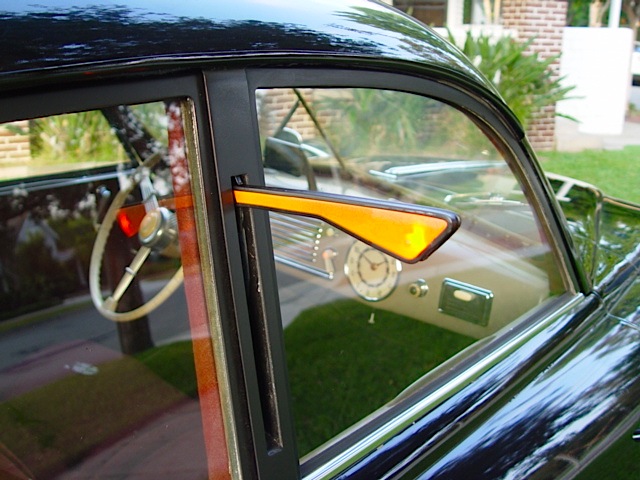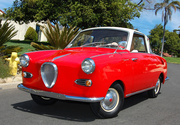When Southern Californian Justin Pinchot is in the market for a new car, he doesn’t just head for the local Auto Row or browse the latest deals online. He goes farther, a lot farther. For example, a British Columbia mechanic located his latest ride, a 1950 Tatra T-600 Tatraplan, in a Canadian barn. “It had green moss growing on it,” Pinchot says, “but its air-cooled, rear-mounted, four-cylinder pancake engine only had about 19,000 miles, and its original red wool interior was perfect.”
“I love the weird stuff. I can’t help myself.”
How a four-door, teardrop-shaped import from then-Communist Czechoslovakia ended up in a Canadian barn is a complicated story involving war reparations, wheat exports, and anti-Communist hysteria (at the height of McCarthyism, the cars were selling so poorly, many were simply barged by the Canadian government into the Straight of Georgia separating Vancouver Island from the mainland and dumped). After its initial discovery in a B.C. barn, the car changed hands several times, but recently, Pinchot finally became the proud owner of this black beauty. “It’s absolutely my favorite car I’ve ever owned,” he says.
Founded in 1850 as a manufacturer of horse-drawn coaches, by 1899, Tatra was one of Europe’s leading automakers, producing a sports car that reached 71 miles per hour. Then, in 1921, an Austrian named Hans Ledwinka was named Tatra’s chief designer. Ledwinka was something of a rock star among European automobile designers between the wars. “Hitler had dinner with Ledwinka many times when he was touring Czechoslovakia prior to the war,” Pinchot says. “‘That’s the car I want for my roads’, Hitler told his designer, Ferdinand Porsche [at the time, Porsche’s company was still a design firm; its famous 911 would not be released until 1964]. It was very well known that Hitler and Porsche stole the idea for the Volkswagen Beetle from Tatra. In fact, after the war, Germany paid Tatra three-million Deutschmarks to settle a lawsuit Tatra had filed in the 1930s.”
During the war, Tatra was forced to build trucks for its occupiers, but its T-87, which is the precursor to Pinchot’s T-600, remained in production, perhaps because the three-headlight, dorsal-fin-equipped sedan was a favorite of German officers. Today, serious car collectors like Jay Leno own T-87s, and in 2010, the “New York Times” named a 1941 T-87 owned by a third Californian, Paul Greenstein, Collectible Car of the Year.

A suicide door in the front and a conventional door in the rear means both open off the car’s central pillar.
“The T-87 is very, very similar,” to the Tatraplan, Pinchot says, “except it’s much more industrial-looking, more early machine-age Art Deco. Mine looks much more like a teardrop, more fluid, later Art Deco.”
While the T-600 has only two headlights, like the T-87, it retains that trademark dorsal fin. “All the Tatra T-series cars had that,” says Pinchot. It wasn’t just for looks or aesthetics. It was to divide the air pressure that went into the air-cooled engine. If you look at the rear deck lid, there’s a space between the roof of the car and the deck lid. That’s where the air goes. It’s actually an air dam. The fin splits the air flow.”
Another feature of the rear-engine Tatraplan is how quiet it is. “There’s a luggage compartment between the backseat and the engine,” Pinchot says. “They did that so it would dampen the noise. You can barely hear the thing running when you’re in it.” For different reasons, Pinchot also loves the doors. “The front ones are suicide doors, they open forward. The back doors are conventional. They both open off the same central pillar.”
And then there are the semaphores, which pop out from within those pillars to signal left or right turns. “When I put those on, people almost crash into me because they don’t know what they are; they don’t realize they’re turn signals. But they’re so cool. You flip a switch, and they pop out and light up.”

Ferdinand Porsche lifted his design for the Volkwagen’s pancake opposed four-cylinder engine from Hans Ledwinka’s Tatra.
Keeping an exotic 1950 import from Czechoslovakia running is not as difficult as you might think. “It’s actually very easy to work on,” Pinchot says, “like a Volkswagen. In fact, when mine needed a voltage regulator, I got a vintage Volkswagen regulator, and it worked fine. It starts every time and runs great. So far, it has not let me down.”
In fact, the car is downright economical, getting between 25 and 30 miles to the gallon. And, as Pinchot puts it, it “hauls ass” on the highway. “It’ll easily do 85 and still have some pedal left,” he says.
Of course, there are a few things that take some getting used to. “It’s a four-speed,” Pinchot says, “but it’s four on the column, and the shifting pattern is backwards. I have to look at the shift pattern diagram every time I drive it. First gear is—let me see if I get this right—forward and up. Second gear is straight down from there. Third gear is toward you and up. And then fourth gear is toward you and down. Don’t even ask where reverse is. It’s really bizarre.”
Pinchot is obviously quite comfortable with the bizarre, as his collection of toy robots and his last automotive love, a 1959 Goggomobil, attest. “I love the weird stuff. I can’t help myself,” he says. Nor is he alone in his affection for his Tatra. “I went for coffee with my wife and brother the other day, and I never got my coffee. They were sitting there, sipping away, but I was busy the whole time talking to people. I can’t take the thing anywhere without drawing a huge crowd. I’ve never seen anything like it.”
(Photos and video by Justin Pinchot)





 For Collectors, Clear Is the New Black
For Collectors, Clear Is the New Black
 This 1959 Goggomobil Is Insanely Cute and Gets 55 MPG. Why Can’t Detroit Do That?
This 1959 Goggomobil Is Insanely Cute and Gets 55 MPG. Why Can’t Detroit Do That? For Collectors, Clear Is the New Black
For Collectors, Clear Is the New Black Riding the Classics, from Chevys to Schwinns
Riding the Classics, from Chevys to Schwinns CarsThe phrase “classic cars” generally conjures a red Ford Mustang convertible…
CarsThe phrase “classic cars” generally conjures a red Ford Mustang convertible… Mari Tepper: Laying it on the Line
Mari Tepper: Laying it on the Line Nice Ice: Valerie Hammond on the Genteel Charm of Vintage Canadian Costume Jewelry
Nice Ice: Valerie Hammond on the Genteel Charm of Vintage Canadian Costume Jewelry How Jim Heimann Got Crazy for California Architecture
How Jim Heimann Got Crazy for California Architecture Modernist Man: Jock Peters May Be the Most Influential Architect You've Never Heard Of
Modernist Man: Jock Peters May Be the Most Influential Architect You've Never Heard Of Meet Cute: Were Kokeshi Dolls the Models for Hello Kitty, Pokemon, and Be@rbrick?
Meet Cute: Were Kokeshi Dolls the Models for Hello Kitty, Pokemon, and Be@rbrick? When the King of Comedy Posters Set His Surreal Sights on the World of Rock 'n' Roll
When the King of Comedy Posters Set His Surreal Sights on the World of Rock 'n' Roll How One Artist Makes New Art From Old Coloring Books and Found Photos
How One Artist Makes New Art From Old Coloring Books and Found Photos Say Cheese! How Bad Photography Has Changed Our Definition of Good Pictures
Say Cheese! How Bad Photography Has Changed Our Definition of Good Pictures Middle Earthenware: One Family's Quest to Reclaim Its Place in British Pottery History
Middle Earthenware: One Family's Quest to Reclaim Its Place in British Pottery History Fancy Fowl: How an Evil Sea Captain and a Beloved Queen Made the World Crave KFC
Fancy Fowl: How an Evil Sea Captain and a Beloved Queen Made the World Crave KFC
The VW Bug’s Rare and Quirky Czech Mate:
Ledwinka was in the Czech prison when Tatraplan was designed. The designers had some serious problems with it so they secretly visited Ledwinka in prison.
Wow! and the wow again. It is a real beauty and teaches us one thing and that is we missed a few good things just because of a blind hatred for communism which had no role to play in the creation of this beauty.
There were a lot of Tatraplans in British Columbia and in western Washington state back then. A dealer on Capitol hill in Seattle sold them for one year (1951 I believe). At one point in the late fifties there were ten Tatraplans parked each day at Bellingham High School. All owned by students (talk about a strange click) one owner was Mike Seale who would build a purpose built sport-racing car with Tatraplan components which he raced for 3-4 seasons at Westwood British Columbia and making class champion in 62 and 63 (d sports).
It’s been many years since I owned one but I’ve had a total of 5, including the sport racer built by Dr. Seale (Seale went on to teach auto engineering at Western Washington University in Bellingham and built several world renown cars….the Viking series)
Had the Communists been able to buy Western products freely, this car might not have ever been built in the first place after WWII.
Having owned and driven many T-600 Tatra automobiles, I must compliment you on yours. Porsche was sued in the fifties by Motokov, builder of Tatra automobiles into the 1980s. The million dollar settlement seems minor now but was real money then.
They were fairly popular in British Columbia and in Washington state. I have heard the story of cars being dumped into the ocean but never believed it. At one time in the late 50s you would see 6 parked together at Bellingham high!
Semaphore signals bring back memories.
My late parents were forever bending or knocking them off when parking our black family Wolseley in the driveway.